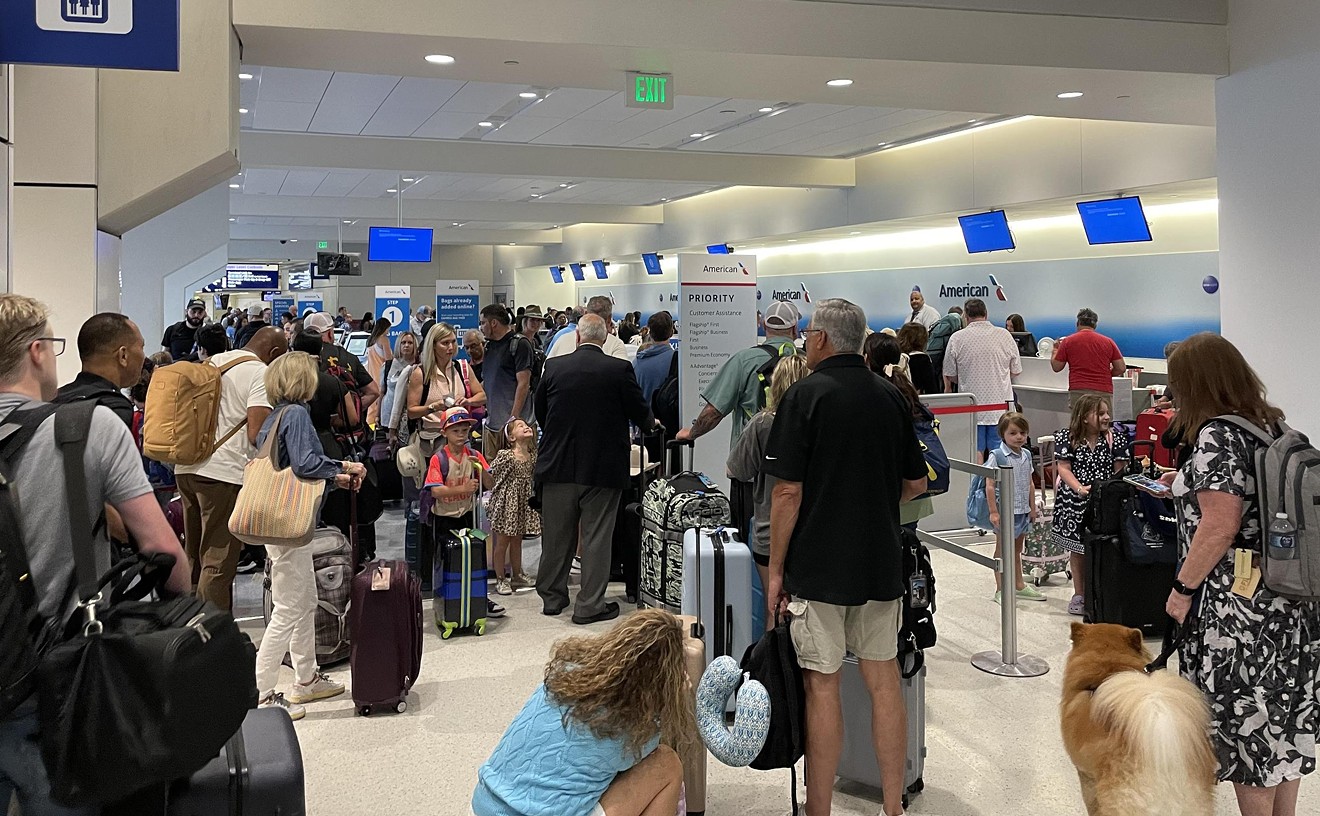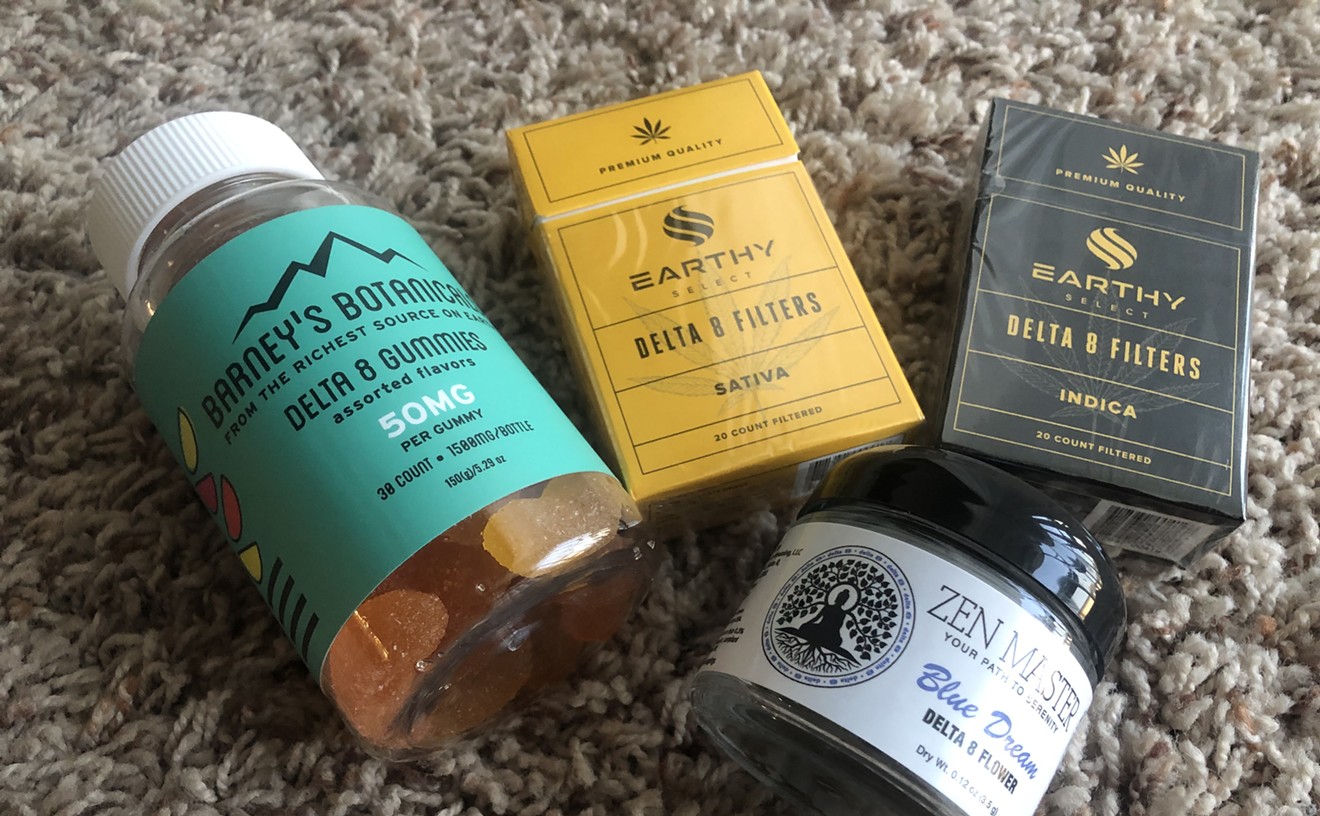Art happens, no matter what. Neither poverty, madness, clueless critics or an unappreciative public can kill the relentless drive to re-imagine the world. Sadly, however, all but a lucky few artists must waste valuable creative energy in soul-crushing regular jobs to survive. But no amount of dog-walking, poop-scooping, telemarketing, sperm-donating or even doctoring or lawyering will stop a real visionary. The Dallas artists you're about to meet persevere in telling their stories through dance, photography or found objects, on canvas or through sculpture. They make their marks on this city with paint, sweat and tears.
Awarded to three cutting-edge local artists from a variety of media, our $2,000 MasterMinds grants aim to help our winners keep creating in a city not known — yet — as a haven for great artistic innovators. We hope our second annual MasterMinds awards will encourage and support homegrown talent and help artists fund new projects — or simply pay the rent.
Our MasterMinds were selected by a panel of seven judges: the Observer's own art director Alexander Flores, theater critic Elaine Liner and arts and culture editor Merritt Martin; 2010 MasterMinds winners Karen Blessen and Matthew Posey; and two guest judges, photographer Allison V. Smith and visual artist and interior designer Leslie Ezelle (recognizable from her stint on the most recent season of HGTV's Design Star). From 45 nominations, the judges narrowed the selection to 10 finalists (see sidebar, page 16). From there, two additional rounds of votes provided the three winning MasterMinds.
We've written in the past about many of our finalists and have followed some of them for years. Today, we salute them, the un(der)sung heroes of Deep Ellum and the Arts District, Oak Cliff and Oak Lawn. On the worst days, you make this city livable. On the best, you finally get your due
Congratulations to our winners Frank Lopez, Katie Toohil and La Reunion, and to all of our finalists.
Frank Lopez
Collodion photographer and educator
The silver nitrate stains on his hands will turn black for a few days, dark as the oil beneath an auto mechanic's fingernails, but Lopez wears them like a badge of honor or, more realistically, the subtle and easily ignored remnants of that morning's shoot.
He sits at a table at a restaurant in Deep Ellum, just a few blocks from his home and studio, where he produces black glass ambrotype photographs from a 19th century formula. The antique process uses photographic plates dipped in a light-sensitive chemical solution and loaded into a camera with a Civil War-era lens. Exposure times are long, and he must race against time to capture and develop his photographs while the plates are still wet. The results are rich, one-of-kind images.
Lopez sips green tea as he talks about cutting and shaving the glass plates that he uses to create art. He's also learning how to restore original 19th-century Union Cases, which will eventually house tintypes for an upcoming show in January. The decorative boxes were once commonly used for displaying photographs, and those Lopez has acquired need new hinges and velvet linings, but their intricate cover designs are in gorgeous condition. He hopes that he will soon be able to reproduce them on his own.
Good with his hands, Lopez grew up watching his father, an auto mechanic, who taught him the family trade and instilled in him a scientific creative process that relies on critical thinking and problem solving as much as Lopez's natural, romantic eye for breathtakingly powerful scenes. As a result, Lopez is an artist unafraid to disassemble his tools just to see how they tick; most of his gear is rebuilt, modified or self-manufactured. Recently, he has retrofitted his truck as a darkroom, so he can process images on location. (Photographers in the 19th century often built horse-drawn mobile darkrooms to allow them to create landscapes using the wet-plate process.) He proudly showed us the big wooden cabinet in his trunk and the tarp he awkwardly drapes over it to work his photographic alchemy away from the studio.
"So, I'm 8 years old and my mom pulls over in this pasture in Oak Cliff — this is when there was still countryside there — and I take a portrait of this horse with a Polaroid. It won an award. There was something magical about that instantaneous result, that capturing of a fleeting moment made permanent," Lopez recalls. In high school, Lopez took a film class in which fell in love with capturing images, and he was the yearbook staff photographer. After a year working in his father's garage, he attended East Texas State University, where he earned a degree in photography in 1990 and worked as an adjunct professor. Today, he teaches honors students at Greenhill School, a private secondary school in Addison where he says his course is as challenging as any college-level class he's taught.
As far as his signature style goes, Lopez is largely self-taught. He attended a one-day workshop in 2005 at the Amon Carter Museum and slowly collected the equipment to produce wet-plate ambrotypes and tintypes, which cast dark-shadowed prints, utilizing a primarily monochromatic chiaroscuro, with bright, almost metallic bursts of unexpected light that "imbue a sense of alternate reality," he says. When Lopez speaks about the technical aspects of his craft, he sounds more like a chemist than artist. His work requires him to delicately fine-tune the "fickle" materials needed to produce the simple tones and shadows that emphasize emotion in his artwork.
Similarly, he is interested in pinhole photography, which, depending on the conditions surrounding the shoot, often creates landscapes with the ephemeral images of passersby, like a fog of spiritual visitors, giving them an almost palpable sense of movement. Surprisingly, Lopez has recently taken to using his iPhone — and color — to capture unexpected and occasionally surreptitious shots. Unlike the considerable setup required for his atavistic wet-plate or pinhole equipment, the iPhone affords him a more subtle, fly-on-the-wall observer's view through which he captures candid moments of life in progress.
That is Lopez's unquestionable modus operandi. Rather than focusing on controversial or polemical subjects, he gravitates toward a poetic open-narrative, occasionally lighthearted but often Kafkaesque. In fact, that's the perfect word to describe his series from Prague, which includes a stunning shot looking out to the brightly lit street from within the Franz Kafka Cafe. A lover of buildings and architecture, Lopez deftly catches mere rust stains on a bridge as if they were purposely placed to highlight the structure's unusual beauty. He captures Big Tex in mid-assembly, head rolling about the grass like a toppled Goliath. His sense of mystery intrigues a viewer from first look.
Lopez developed this skill traveling internationally and becoming "lost" in remote countries, often unable to speak the native language. He prefers this, he says, because an interpreter, or perhaps even language itself, loses the "essence of communication." By communicating primarily through gestures and body language, and by using vintage cameras that suggest his goal is art, rather than a political or some other nefarious purpose, he says he feels as though he helps return a democratization to photography. These language-free sessions become more of a deliberate, collaborative process in which his subjects take a leap of faith in him as an artist. He first realized this possibility in Vietnam while photographing the baby blue car that Buddhist monk Thich Quang Duc took to Saigon before immolating himself in 1963. Pilgrims happened into the shot, but rather than waiting for them to clear, Lopez envisioned a moment of symbolic human interaction, spanning cultural barriers and time itself.
International travel has been so significant to Lopez's personal development, and has so acutely informed his self-identity as an artist, that he says if money were no object, he would form a foundation to fund similar trips for students in less affluent schools. As an educator, he believes this type of cultural immersion through art and imagery teaches students to become citizens of the world, no longer mere users, but also contributors. More modestly, he hopes to buy equipment for a bigger camera that he is refurbishing and more glass to continue his ambrotypes, in addition to offering a workshop for underserved students. While teaching can be draining at times, he says he will likely never stop. "If the work's important to you, if you're passionate, you'll find time for it," he says. And Lopez always finds time to get a new shot.
Katie Toohil
Dancer, performance artist and freelance go-getter
"I'll help you do yours," Katie Toohil says when somebody asks about her long, sandy-colored dreadlocks. "Dreading hair is kind of something I'm into."
We meet up with Toohil, a 27-year-old Oak Cliff girl, at the all-vegan Spiral Diner while she's on her lunch break from her job in creative advertising. Anyone who has seen photos from her recent production, Grieve, could recognize her in a heartbeat. From stretched earlobes to studs in each nostril, Toohil stands out in all of the right ways.
"One of my friends calls me a 'freelance go-getter.' I really love that description," she says about the dreading, just one of her eclectic pursuits. Go-getter she is. As part of her healing process following the unexpected death of her father last January, Toohil thrust herself into her first original dance production, Grieve, a combination of dance modalities from carefully planned choreography to ecstatic movement, all set to the indie-rock playlist that Toohil had assembled in the days following his death. For Toohil, the music is where dance begins, and she chose songs based on images that formed organically, and sometimes unexpectedly, in her mind. "The songs in Grieve were ones that caused me to have to pull over while driving because I was suddenly crying. Or songs that made me feel angry or lost or hopeful."
Toohil listened to the songs repeatedly and in different ways — sometimes with headphones, sometimes on a car stereo and other times at home. After hearing the songs so many times, she says she started picking out rhythms that weren't immediately obvious, and in uncovering those hidden beats she began sketching unexpected, dynamic movements. A dancer since she was a child, Toohil had always planned on someday returning to her passion and perhaps even producing a show of her own, but she'd never taken the opportunity. For many would-be dancers, the art form becomes a body-breaking, endless search for perfection, all-consuming and destructive. Many people don't have the "right" body for it, and those who do often wind up losing their passion in grueling training.
Having given up her dreams of dancing professionally at 16, Toohil studied performance at Massachusetts College of Liberal Arts and stayed involved in theater production. The unexpected loss and subsequent trauma she faced last winter encouraged her to return to dance in order to find her way back through the pain and darkness. Devastated, but not defeated, Toohil believed she could create, rather than destroy. After her father's death, she says, she felt a sense of purpose, as if the universe was telling her it was finally time to dance again.
"There's not a lot that you can do in the grieving process, but I didn't want to just sit around or retreat into myself," Toohil says. "I wanted to feel that, if my dad could see me, from wherever he has disappeared into the ether, he would be proud of me for moving, getting up and pushing that grieving energy out of my body. I knew I needed something to help me get over the hump of wanting to disconnect and withdraw."
Raised in western Massachusetts, Toohil first came to Dallas to pursue another passion, a long-term relationship with a "long-haired hippie" from Balch Springs, whom she met nearly a decade ago on the message boards on the Dallas-based Polyphonic Spree's website. Today, one would be hard-pressed to find a more fervent Oak Cliff evangelist. "I always felt a connection with Dallas because of the music here, but I really only thought it would be a place I would visit," she says. "Now, I'm moving everyone I know down. I look around in Oak Cliff, and these are my people."
Toohil's relationship with Dallas seems symbiotic. She has not only produced a piece that enriched and enlivened our arts scene, but she also shared the intimate details of her process on the Observer's culture blog, Mixmaster. Toohil says she loves Dallas because, despite the city's size, it still has the vibe of a smaller city. She feels as though she is on the ground floor of an arts revolution in a place where she can carve a niche. Unlike other cities historically saturated with world-class artists — and their egos — here, finding help with artistic projects is less about "Who do you know and what can you do for me?" than "What can we create?" she says.
That certainly rings true with regard to the help she found for Grieve. Acting as both creative director and logistical manager, Toohil was able to work out a series of deals with local business owners for rehearsal space, even cleaning one studio in exchange for time there. She says she believed patrons responded so positively because they could relate to her work from their own experiences. Ultimately, she learned that great things come to those who are willing to humble themselves and just ask.
So she asked. She held formal auditions, publicizing as much as possible, but initially gained the interest of a modest six dancers whose skills ranged greatly. Toohil pressed forward and soon found herself contacted by others who had missed the initial round of auditions but who hoped there might be room for them. Toohil added to her team an eclectic group with skill levels ranging from a professional ballroom dancer to those who had danced only in front of the bathroom mirror. For Toohil, Grieve was less about technical ability and more about individuals who were willing to confront such a personal and sensitive subject head-on. As long as they had a heartbeat, she says, the moves would find them. "Grieve wasn't about making a polished production so much as making a program for people who needed it. It was mediation through movement." Toohil tells of her struggle to cast Grieve in her forthright second Director's Notes installment on Mixmaster, "When Low Audition Turnout Becomes Surprisingly Rewarding."
Raw honesty is just how Toohil operates. As she speaks, the dancer's mannerisms are both controlled and joyful, and when she looks you in the eyes, you believe you're about to hear something unquestionably true. Today, Toohil has stepped back and reflects on the production as a vastly meaningful, but complete, period of her life. "Now, everything is pointing toward the future," she says, "I feel like I accomplished what I needed through Grieve as part of my personal process."
Toohil, who carries a notepad at all times, has returned to her eager listening, compiling playlists and finding songs that move her. She says that if she were to come across an unexpected windfall she would refocus that gift by giving back to local arts programs, investing a significant portion into developing herself as a dance and performance art teacher and squirreling some away for the future project simmering in her earbuds.
Most of all, Toohil just wants to connect with you by unabashedly sharing her pain and passion, joy and freedom. "Telling stories is really my jam," she says with a smile and shrug. "It's what turns me on."
La Reunion
Artists’ colony, social utopia
Reunion Tower stands as an indelible signature on the western edge of the Dallas skyline, but few Dallasites know the history of its namesake, La Reunion, a 19th-century artists' colony founded in 1855 by Victor Considerant, a follower of French philosopher François Marie Charles Fourier. A socialist utopian experiment in which both men and women could vote and individuals could own private land, La Reunion comprised skilled artisans from France, Belgium and Switzerland, but few, if any, farmers or ranchers. While the population initially flourished, with some accounts suggesting it reached nearly 800 at its zenith, the community quickly floundered, unable to produce adequate food. In 1860, the land that now surrounds Reunion Tower was incorporated into the city of Dallas, and the artisans dispersed, some settling in the city — along Swiss Avenue, for instance — and forever changing the cityscape.
Mostly forgotten, the spirit of La Reunion was revived in 2006 by founders Catherine Cuellar and 2010 MasterMind finalist Sarah Jane Semrad, who hoped to improve upon the original model of love, justice and art by enlisting sophisticated economic managers, such as interim Executive Director Catherine Horsey. A geologist, conservationist and financial ace, Horsey has a long record of nonprofit management and was even honored with an official "Catherine Horsey Day" in 2000 by former Mayor Ron Kirk for her contributions to the city. While Horsey does play left-handed mandolin and right-handed banjo, she considers her role at La Reunion to be that of regeneration, reinforcing La Reunion's vision from a practical, fiscally solid perspective. Today, La Reunion is an artists' residency in the making that aims to foster creative development both for the artists there and in the community at large while maintaining fiscal and ecological sustainability. It is a tall order, but if anyone can do it, Horsey can.
The past five years have seen great strides in realizing Cuellar and Semrad's vision of La Reunion's revival, though much of that time has been spent sorting out legal issues regarding ownership of the bucolic 35 acres that will someday be home to artists. The battle was recently resolved with the signing of a 50-year lease, and the community is finally ready to begin accumulating capital, some of which will restore a two-bedroom house and studio space and prepare them for residents. Horsey says this refurbishing will require very little money and, because the organization has already been successful with leveraging expenses for community programming — for instance, UNT recently paid for lunches for school children who were taking part in a workshop — she believes the biggest future expense La Reunion will face will be the artists' stipends.
Chosen by a jury, these artists will come from a variety of backgrounds and will work in diverse fields, from studio painting to dance or poetry. They will remain at La Reunion for a specified period of time, "whether two weeks or two years," based on individual needs and tailor-made residencies. As part of their contract, the artists in residency will take part in community programming, further enriching current projects such as Art Chicas, a 5-year-old program that allows female Dallas artists to mentor high-school girls. Horsey projects that La Reunion will be ready to host its first artists in residency next fall. She hopes for a mix of local artists and implants who can bring the city an outsider's perspective.
While La Reunion awaits the day when it can house artists, the organization has already begun cultivating the space with installations, some of which consist of ephemeral, decomposing eco-art. Horsey tells us of one exhibition in which the artist reworked thin pieces of lumber, sharpening the ends to a point and drilling a hole in the middle before inserting colored PVC pipe to create the effect of a multitude of massive colored pencils. The installation was interspersed around trails to greet visitors as they tour the property. Such large-scale, natural pieces are, in fact, one of the unique advantages of a private art haven — the land itself becomes a canvas. Predominantly black-land prairie and, according to Horsey, one of the most endangered eco-systems in North America, La Reunion contains rolling hills, old trees and springs that run all summer. Because of its vulnerable nature, La Reunion requests that all visitors call ahead for tours and be accompanied by members of the development staff to ensure preservation of the land as a historical treasure. If the land itself isn't culturally significant enough, it boasts one particularly fascinating permanent "installation," an iconic, 45-foot concrete trestle, a ghostly remnant from the Interurban Railway, now celebrated as a monument to "where we are," memorializing the pastoral life outside the city limits and untouched further by industrialization.
Until now, the bulk of La Reunion's capital has been spent to ensure the land's rightful ownership. As La Reunion moves to this next phase, Horsey, a consultant on resource-efficient buildings, says that a MasterMinds grant will make huge strides in rehabbing the property's house, and she believes there will be remaining funds to begin building future residents' stipends. Dedicated to the enrichment of both individual artists, the larger arts community and the city at large, La Reunion sits eagerly on the cusp of a new beginning.
ARTOPIA
Meet the artists and celebrate their work with food, fashion and music at Dallas Contemporary, 161 Glass St., 8 to 11 p.m. this Saturday.










